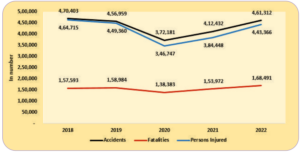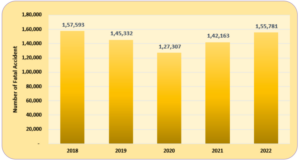
The Union government should prioritise reinforcement of the Motor Vehicles Act (MV Act) 2019, implementing speed management initiatives, and developing comprehensive national and state road safety action plans. An informed debate on the incumbent government’s performance, including legislative and institutional reforms, and safety initiatives, is crucial for understanding achievements, challenges, and direction for the future.
The Narendra Modi government has made significant efforts to improve the transportation and road safety situation through legal, policy, and institutional reforms. However, despite these efforts, road crash statistics continue to rise annually, indicating a need for further action. The incoming Union government must focus on strengthening road safety laws, enforcement of speed management and safety standards such as child helmet regulations, and establishment a detailed action plan with clear targets, timelines, and accountability.
India boasts of the world’s second-largest road network, with significant infrastructure developments since 2014. The national highway network has expanded by 60%, with a notable increase in four-lane roads and a reduction in smaller lanes. Construction speed has also increased, contributing to the economy’s growth. Road construction expenditure is projected to rise substantially, reflecting ongoing infrastructure improvements and connectivity enhancements.
READ I Cautious optimism: RBI prioritises inflation over growth
Government initiatives in road safety
The government has launched several safety initiatives, such as the Bharat New Car Assessment Programme, vehicle scrapping policies, digital tools for highway project management, and comprehensive vehicle registration and licensing systems. Amendments to the Motor Vehicle Act and efforts in safety audits, black spot identification, and public awareness campaigns highlight the government’s commitment to improving safety. However, the effectiveness of these measures requires thorough evaluation and sustained efforts.
The Bharat New Car Assessment Programme evaluates the safety features of passenger cars. The Vehicle Scrapping Policy seeks to phase out older, less safe vehicles, enhancing safety. Digital tools such as Rajmarg Yatra and NHAI One have been introduced to streamline project execution and improve customer grievance redressal. These initiatives reflect a targeted approach to addressing various aspects of road safety and infrastructure improvement.
Trends in number of accidents, fatalities and injuries: 2018-2022

Trends in the number of Fatal Accidents: 2018-2022

The adoption of technology in road safety measures is notable, with the launch of mobile applications. These tools enhance transparency and accountability in road management. The comprehensive implementation of Vahan and Sarathi across RTOs exemplifies the government’s commitment to leveraging technology for better governance in safety and transport management.
Alarming road crash statistics
Despite significant investments in road infrastructure, road accidents, fatalities, and injuries have alarmingly increased, with speeding as a leading cause. Many crash victims are young adults, underscoring the urgent need for effective road safety measures.
While legislative reforms like the Motor Vehicles (Amendment) Act, 2019, have been steps in the right direction, their impact is limited by challenges in implementation across states. The Supreme Court has highlighted the need for further amendments to address issues like licensing regulations for light motor vehicles. These ongoing legal challenges highlight the complexity of governance and the need for continuous legislative evolution.
The road safety crisis is underscored by stark statistics, with over 460,000 accidents and 168,491 fatalities in 2022 alone, marking an all-time high. This upward trend in accidents and injuries, particularly among the working-age population, highlights the critical need for effective safety measures. Speeding remains the predominant cause, necessitating stringent speed management and enforcement strategies to mitigate this risk.
The Supreme Court of India has urged further amendments to the MV Act, focusing on licensing regulations and other safety concerns. Effective speed management is crucial, given the high percentage of speed-related accidents. Lessons from regions like West Bengal, with successful speed management guidelines, can guide nationwide policies.
Urban areas present unique challenges, with varying fatality rates across cities. Learning from cities with declining accident rates can inform better speed management and law enforcement strategies.
There is a pressing need for a structured and well-coordinated Road Safety Action Plan at both national and state levels. Such a plan should encompass clear objectives, targets, and accountability mechanisms to ensure effective implementation of safety initiatives.
(Madhu Sudan Sharma is senior programme officer at CUTS International, a leading policy research and advocacy group.)
